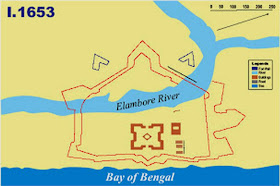 |
| Evolution of Fort St.George (After Col. DM Reid). Exhibit at Fort Museum, Fort St.George |
 |
| Col. DM Reid's Map Showing Fort St.George and its structures in 1653 |
 |
| Dr. John Fryer's sketch map of Fort St. George (1673) in copper engraving - adopted from a Dutch source. |
At the Fort Museum, Fort St.George, Chennai, one can see maps and illustrations which documents
the evolution of the fort and settlement over the centuries. Col.
D.M.Reid (Douglas Muir Reid) prepared drawings of the fort with Madras
volunteers. These drawings describe the evolution of this fort. He has also written a book title: 'The Story of Fort St. George.'
 |
| Col.DM Reid (Source: V.Sriram) |
1639 -- Francis Day (1605–1673), an English trader and served as a factor of the British East India Company's factory at Masulipatnam from 1632 to 1639, received a grant of land to build a factory and warehouse for their trading enterprises from Damarla Venkatappa Nayak, the local chief or Nayak of Wandiwash to erect a trading outpost, which grew into Fort St. George. During that particular time, the Coromandel Coast (from Pulicat up to Santhome) was governed by the Raja of Chandragiri through Damarla Venkatappa Nayak. Venkatappa Nayak was positioned at at Wandiwash and his brother, Ayyappa Nayak was living at Poonamallee. Ayyappa Nayak was instrumental in wooing the British East India Company in selecting the strip of land measuring about 3 square miles.
22nd August 1639 -- The strip of land was handed over by Damarla Venkatappa Nayak and his brother Ayyappa Nayak to Francis Day and his Superior Andrew Cogan. Beri Thimappa / Beri Thimmanna, who served as the dubash (interpreter) and chief negotiator for Francis Day and Andrew Cogan, was also instrumental in granting the land by Nayak brothers.
It was on 22 August 1639 that a sliver of land, where now stands Fort St George, was handed over by the local Nayak rulers to the East India Company’s Francis Day, his dubash Beri Thimmappa, and their superior, Andrew Cogan.
1640 -- The construction of the Fort began in right earnest on 01st March 1640, which was completed in 13 years. The Fort House, the Governor’s residence was built at the Centre, surrounded by the “White Town” for the English and other Europeans. A trading outpost of the factory erected with in the first enclosure of the 'inner walls'. Beri Thimappa, the chief merchant, established Black Town, a settlement of weavers and other natives, to the north of this walled enclosure. The Fort of Madras named as Fort St. George.
Mid-1600 -- An outer wall constructed around the growing White Settlement.
YouTube
No comments:
Post a Comment